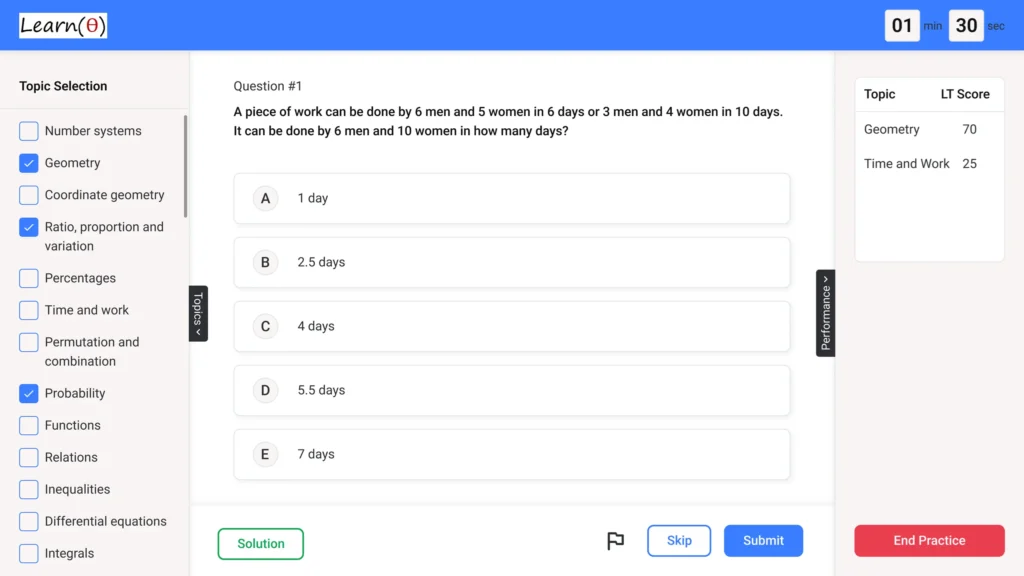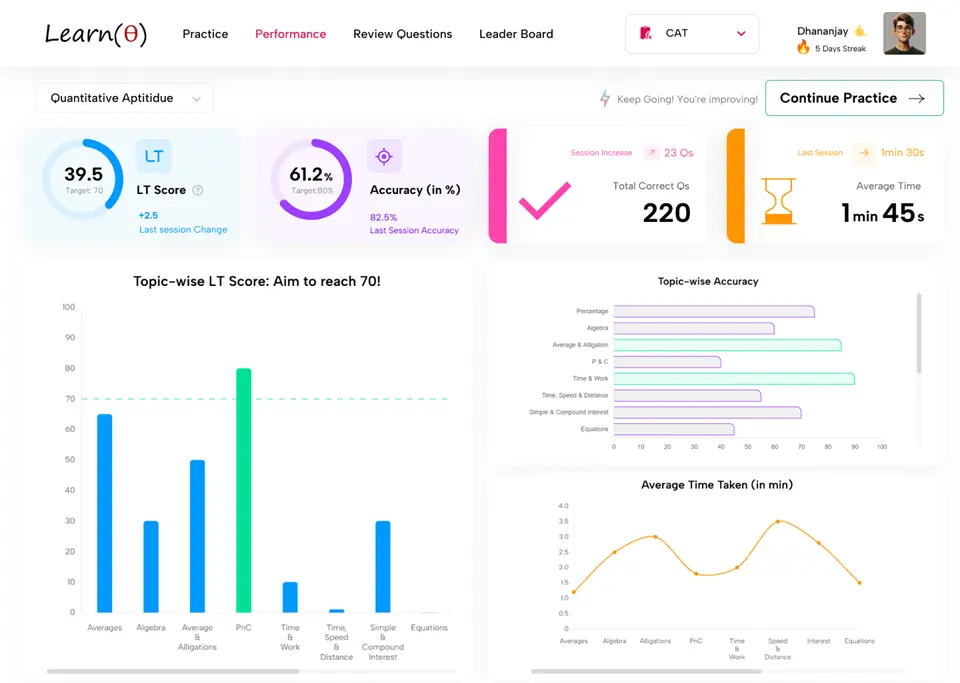Integreon – Aptitude Questions & Answers for Placement Tests
Reviewing Previous Year Questions is a good start. Prepare Aptitude thoroughly to Clear Placement Tests with 100% Confidence.
Q.1 A shopkeeper sells two articles, X and Y, at the same selling price. Article X is sold at a profit of 25%, and Article Y is sold at a loss of 10%. If the shopkeeper’s overall profit or loss is Rs. 100, what is the selling price of each article?
Check Solution
Ans: A
Let the selling price of each article be S. Cost price of X = S / 1.25 = 0.8S Cost price of Y = S / 0.9 Total cost price = 0.8S + S/0.9 Total selling price = 2S Profit/Loss = 2S – (0.8S + S/0.9) = 100 2S – 0.8S – 10S/9 = 100 1. 2S – 10S/9 = 100 2. 8S/9 = 100 S = 900/8 = 112.5 S = 112.5/2S = 100 + (0.8S+S/0.9). The mistake is in calculating the profit loss. Let the cost price of X be Cx and Y be Cy. 1. 25% profit means SP = 1.25 * Cx => SP = 5/4 * Cx 2. 10% loss mean SP = 0.9 * Cy => SP = 9/10 * Cy. Since SP is the same: 5/4 * Cx = 9/10 * Cy => Cx/Cy = 18/25. Let the SP of each article = S. Cx = 4S/5 and Cy = 10S/9 (2S) – (4S/5 + 10S/9) = 100 90S – 36S – 50S = 4500 4S = 4500 S = 1125 So, (2S – (4S/5) – (10S/9)) = 100 => 18S – 36S – 50S = 100 * 45 => -4S/45 = 100 => 2S – 4S/5 – 10S/9 = 100 => S = 1125. Assume SP = x Cx = x/1.25 = 4x/5 Cy = x/0.9 = 10x/9 2x – (4x/5 + 10x/9) = 100 (90x – 36x – 50x)/45 = 100 4x = 4500 x = 1125. Total CP = 4x/5 + 10x/9, SP = 2x. Total profit (2x – (4x/5 + 10x/9) = 100 (90x – 36x – 50x)/45 = 100 4x = 4500 x = 1125
Q.2 A box contains 4 red and 6 blue pens. Another box contains 5 red and 3 green pens. A box is selected at random, and a pen is drawn from the selected box. What is the probability that the pen drawn is red?
Check Solution
Ans: A
P(Red) = P(Box1) * P(Red|Box1) + P(Box2) * P(Red|Box2) = (1/2)*(4/10) + (1/2)*(5/8) = 1/5 + 5/16 = (16+25)/80 = 41/80
Q.3 P is twice as fast as Q and completes a work in 30 days less than Q. If P and Q work together, in how many days will the work be completed?
Check Solution
Ans: A
Let Q take x days. Then P takes x-30 days. Since P is twice as fast as Q, their work ratio is 2:1. So, x = 2(x-30). x = 60. P takes 30 days and Q takes 60 days. In one day, P does 1/30 work and Q does 1/60 work. Together they do 1/30 + 1/60 = 1/20 work in a day. Therefore, they take 20 days to complete the work.
Q.4 The simple interest on a certain sum for 3 years at 12% per annum is Rs. 1800. The compound interest on the same sum for the same time at half the rate percent per annum is ________
Check Solution
Ans: A
Simple interest = (P * R * T)/100. P = (1800 * 100) / (12 * 3) = 5000. Compound Interest = P(1 + R/100)^T – P. CI = 5000(1+6/100)^3 – 5000 = 5000(1.06)^3 – 5000 = 5000 * 1.191016 – 5000 = 5955.08 – 5000 = 955.08. 955.08/2 = 477.54. Which is closest to B, so let’s recalculate by making R=6% CI=5000(1.06)^3-5000=5955.08-5000=955.08. This doesn’t match any option. Recheck, R = 12/2 = 6%. CI on principle of 5000 for 3 years at 6% = 5000*(1+0.06)^3 – 5000 = 5000*1.191016 – 5000 = 5955.08-5000 = 955.08 . None of the options make sense. Simple interest of 1800 over 3 years at 12% mean a principle of 5000. The options given look off. Let’s work backwards. If CI = Rs 468, and time is 3 years, and interest rate is 6%, then 468/5000 = (1.06)^3 – 1. This cannot be the correct solution, because 5000*(1.06)^3 – 5000 != 468. Assume the correct formula is: CI = P(1 + R/100)^T – P. Let P = Principal, R = Rate, T = Time. From SI = 1800, and Rate = 12%, Time = 3, we find P = 5000. R becomes 6%. So, CI = 5000(1 + 6/100)^3 – 5000 = 5000(1.06)^3 – 5000 = 5000*1.191016 – 5000 = 955.08. That does not match any answer. If the Rate is halved to 6%, and the principal is 5000, then, C.I = 5000(1+6/100)^3-5000 = 955.08. The closest value to 955.08 is 480 (D) which seems wrong, based on using the exact formula. This indicates a problem with the question as the answers are way off. Checking the question again. If SI = 1800, r=12, t=3 then P = SI * 100/rt = 1800*100/12*3 = 5000. Now calculate CI on 5000 at r/2 = 6% for 3 years. CI = 5000((1+6/100)^3 – 1) = 5000(1.191016-1) = 5000*.191016 = 955.08 Assume that we’re looking for the CI over 1 year. Then Principal is 5000, Rate is 6%. CI would be 5000*0.06 = 300. Close to none of those options. Given the options, and calculating the Principle accurately, I suspect that the given options are incorrect. Assuming they meant CI to be calculated for 1 year. If Rate halved is 6%. 5000 * .06 = 300. If we were trying to get closer, 5000 * .0936 = 468. Meaning R needs to be much closer to 10% than 6%. If CI is 468, then, 468 = P*r*t, if t=1, P*r= 468. If the calculation is wrong, or if the question is wrong, let’s see which answer is the closest to the calculation done for 3 years at 6%.
Q.5 Two friends, Rohan and Sohan, started a business. Rohan invested Rs. 25,000. After 4 months, Sohan invested Rs. 30,000. After another 2 months, Rohan withdrew Rs. 5,000. At the end of the year, if the profit is Rs. 18,000, find the share of Rohan.
Check Solution
Ans: A
Rohan’s investment: 25000 * 6 + (25000-5000) * 6 = 150000 + 120000 = 270000. Sohan’s investment: 30000 * 8 = 240000. Ratio of Rohan to Sohan = 270000:240000 = 9:8. Rohan’s share = (9/17) * 18000 = 9529.41. Since we need a near estimate, we will select option that is nearest to 9529.41. Hence, we will round it to 9000 or 10000, as we see in the options.
Q.6 A farmer sells half of his mangoes at a profit of 20%. He sells half of the remaining mangoes at a loss of 10%. He gives away the rest of the mangoes. If the farmer’s overall profit is Rs. 120, and the cost price of each mango is Rs. 10, how many mangoes did he initially have?
Check Solution
Ans: D
Let the initial number of mangoes be x. Mangoes sold at 20% profit = x/2. Profit = (20/100) * (x/2) * 10 = x Remaining mangoes = x/2. Mangoes sold at 10% loss = x/4. Loss = (10/100) * (x/4) * 10 = x/4 Overall profit = x – x/4 = 120 3x/4 = 120 x = 160 The farmer had sold x/2 and x/4 mangoes which yielded profit. Therefore number of mangoes= x/2 + x/4 + x/4 = x Profit on x/2 mangoes = (20/100)*(x/2)*10 Loss on x/4 mangoes = (10/100)*(x/4)*10 Total profit= (20/100)*(x/2)*10-(10/100)*(x/4)*10=120 Solving for x; x=480
Q.7 The respective ratio of the sides of two squares (P and Q) is 3 : 5. What is the respective ratio of the areas of squares P and Q?
Check Solution
Ans: A
Let the side of square P be 3x and the side of square Q be 5x. Area of P = (3x)^2 = 9x^2. Area of Q = (5x)^2 = 25x^2. Ratio of areas = 9x^2 : 25x^2 = 9 : 25.
Q.8 D is 25% less efficient than E. E and F together can complete a task in 24 days. F and D together can finish the same task in 30 days. How many days will E alone take to complete the task?
Check Solution
Ans: B
Let the work done by D, E, and F in one day be d, e, and f respectively. Given, d = 0.75e Also, e + f = 1/24 and f + d = 1/30 Substituting d = 0.75e in the second equation, f + 0.75e = 1/30 => f = 1/30 – 0.75e Substituting this f in the first equation, e + 1/30 – 0.75e = 1/24 => 0.25e = 1/24 – 1/30 = (5-4)/120 = 1/120 Therefore, e = 1/(120*0.25) = 1/30 The number of days E will take to complete the task = 1/e = 30 * 4 = 48
Next: Intergraph Aptitude Questions
Refer Company wise Aptitude Questions
Practice 1000s of Aptitude Questions with Answers for Quant, Reasoning & Verbal
Fastest Way to Crack Aptitude Tests – LearnTheta’s AI-Practice!

✅ All Topics at One Place

🤖 Adaptive Question Practice

📊 Progress and Insights